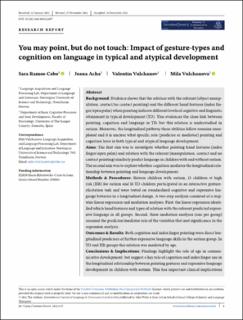| dc.contributor.author | Ramos Cabo, Sara | |
| dc.contributor.author | Acha, Joana | |
| dc.contributor.author | Vulchanov, Valentin | |
| dc.contributor.author | Vulchanova, Mila Dimitrova | |
| dc.date.accessioned | 2022-03-07T14:15:29Z | |
| dc.date.available | 2022-03-07T14:15:29Z | |
| dc.date.created | 2021-12-23T15:46:59Z | |
| dc.date.issued | 2022 | |
| dc.identifier.citation | International journal of language and communication disorders. 2022, 1-17. | en_US |
| dc.identifier.issn | 1368-2822 | |
| dc.identifier.uri | https://hdl.handle.net/11250/2983508 | |
| dc.description.abstract | Background
Evidence shows that the relation with the referent (object manipulation, contact/no contact pointing) and the different hand features (index finger/open palm) when pointing indicate different levels of cognitive and linguistic attainment in typical development (TD). This evidences the close link between pointing, cognition and language in TD, but this relation is understudied in autism. Moreover, the longitudinal pathway these abilities follow remains unexplored and it is unclear what specific role (predictor or mediator) pointing and cognition have in both typical and atypical language development.
Aims
The first aim was to investigate whether pointing hand features (index finger/open palm) and relation with the referent (manipulation, contact and no contact pointing) similarly predict language in children with and without autism. The second aim was to explore whether cognition mediates the longitudinal relationship between pointing and language development.
Methods & Procedures
Sixteen children with autism, 13 children at high risk (HR) for autism and 18 TD children participated in an interactive gesture-elicitation task and were tested on standardised cognitive and expressive language batteries in a longitudinal design. A two-step analysis consisted of a stepwise linear regression and mediation analyses. First, the linear regression identified which hand features and types of relation with the referent predicted expressive language in all groups. Second, three mediation analyses (one per group) assessed the predictor/mediator role of the variables that met significance in the regression analysis.
Outcomes & Results
Both cognition and index finger pointing were direct longitudinal predictors of further expressive language skills in the autism group. In TD and HR groups this relation was mediated by age.
Conclusions & Implications
Findings highlight the role of age in communicative development, but suggest a key role of cognition and index finger use in the longitudinal relationship between pointing gestures and expressive language development in children with autism. This has important clinical implications and supports the view that index finger pointing production might be a useful tool in the intervention for communicative and language abilities in autism. | en_US |
| dc.language.iso | eng | en_US |
| dc.publisher | Wiley | en_US |
| dc.rights | Attribution-NonCommercial-NoDerivatives 4.0 Internasjonal | * |
| dc.rights.uri | http://creativecommons.org/licenses/by-nc-nd/4.0/deed.no | * |
| dc.title | You may point, but do not touch: Impact of gesture-types and cognition on language in typical and atypical development | en_US |
| dc.type | Peer reviewed | en_US |
| dc.type | Journal article | en_US |
| dc.description.version | publishedVersion | en_US |
| dc.source.pagenumber | 1-17 | en_US |
| dc.source.journal | International journal of language and communication disorders | en_US |
| dc.identifier.doi | 10.1111/1460-6984.12697 | |
| dc.identifier.cristin | 1971823 | |
| cristin.ispublished | true | |
| cristin.fulltext | postprint | |
| cristin.qualitycode | 1 | |

